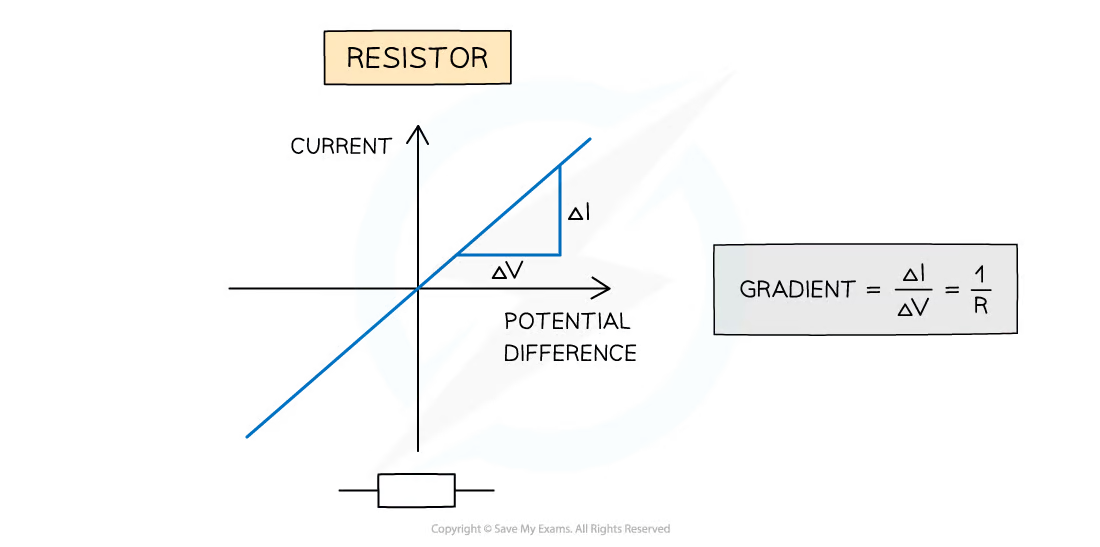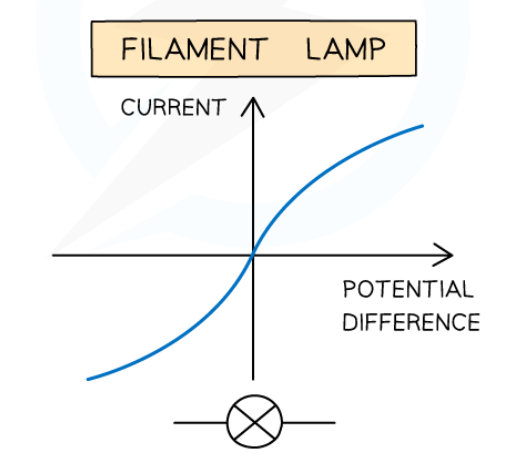Chapter 9: Energy, power and resistance
1/23
Earn XP
Name | Mastery | Learn | Test | Matching | Spaced |
|---|
No study sessions yet.
24 Terms
The flow of current in circuit symbols
In on the left
Out on the right
Potential difference
The same as voltage
A measure of the energy transferred by charge carriers
WORK IS DONE BY THE CHARGE CARRIERS
Definition of p.d
One volt is the p.d across a component when 1J of energy is
transferred per unit charge
1V = 1JC-1
Equation of p.d
V = W / Q
V = p.d measured in volts
W = Energy transferred (by charge Q) / Work done
measured in Joules
Q = Charge (elementary charge on an electron - 1.6 × 10-19 )
measured in coulombs
Electromotive force (emf)
EMF is when charged particles gain energy from a source
Greater the emf, the more energy per coulomb has
been transferred
WORK IS DONE ON THE CHARGE CARRIERS
Definition for emf
The measure of the electrical energy per unit
charge produced by the source (e.g. battery or cell)
Equation of emf

Difference between emf and p.d

Difference between emf, p.d, and work done
EMF - picking charge up
P.D - using it
Work done - dropping it off
Relationship between emf, terminal voltage and lost volts
EMF - theoretical max value (voltage) a cell can put out / make
TERMINAL VOLTAGE - reading on a voltmeter
LOST VOLTS - difference between the two
emf = VT + VL
VT - terminal voltage
VL - lost volts
Thermionic emission
The metal (a wire filament) is heated by passing an electric current through it. The filament (cathode), is in an evacuated glass tube with a metal plate (anode).
The electrons emitted from the filament are attracted to the anode by connecting a high voltage power supply between anode and the cathode.
There are no gas molecules in the tube to stop the electrons, so the electrons are accelerated to the anode where they pass through a small hole to form a narrow beam.
Electrons emitted from cathode by thermionic emission.

The speed of each electron
eV = ½ mv2
e = fundamental charge on an electron
The electron volt
The KE of an electron after it has been accelerated from rest through a p.d of 1V.
the energy gained in one eV= accelerating voltage
[1V - 1eV]
Converting between Joules and eV
J to eV
divide by 1.6 × 10-19
eV to J
multiply by 1.6 × 10-19
Relationship between current and resistance
↑ Current (I) when ↓ Resistance (R)
↓ Current (I) when ↑ Resistance (R)
^inversely proportional
Resistance
Resistance is how hard it is for current to flow
high resistance means low current
1 Ω of resistance is when 1V flows per 1A
Ohm’s Law
For a conductor at a constant temperature, the current ∝ p.d across it
ohmic conductor / metal → the resistance doesn’t change as the voltage does
How to change the current
add a variable resistor anywhere
I-V graph for resistor

I-V characteristics for resistor
V is directly proportional to I
obeys Ohm’s law and is an ohmic conductor
resistance is constant - straight line
behaves the same way regardless of polarity
I-V graph for a filament light bulb

I-V characteristics for a filament light bulb
V is not directly proportional to I
doesn’t obey Ohm’s and isn’t an ohmic conductor
resistance isn’t constant and can be determined by V/I at a point
behaves the same way regardless of polarity
I-V graph for diode

I-V characteristics for diode
V is not directly proportional to I
doesn’t obey Ohm’s and isn’t an ohmic conductor
resistance isn’t constant and can be determined by V/I at a point
behaviour depends on the polarity